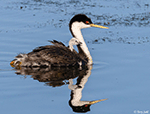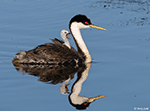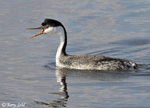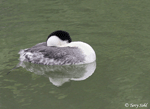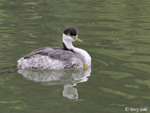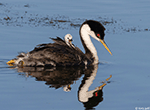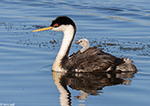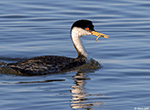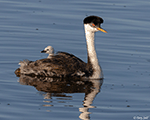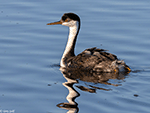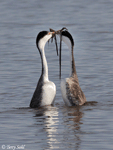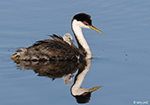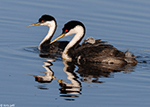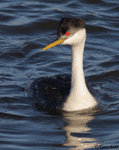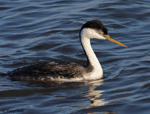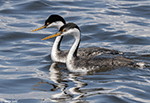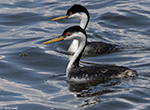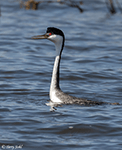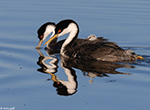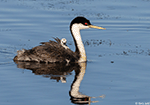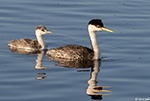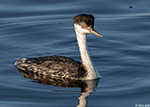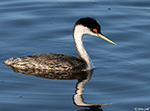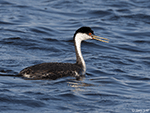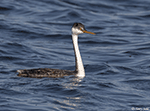| Length: 22 to 29 inches | Wingspan: 31 to 40 inches | Seasonality: Summer / Migrant |
| ID Keys: Long greenish yellow bill, black cap extending below eye (summer), long slender neck | ||
 Identical in size and shape to Clark's
Grebe, once considered to
be a lighter morph of the Western Grebe. Bill colors are slightly
different, and the Clark's Grebe has white both above and below the eye.
Note that in winter, facial patterns are nearly identical for both species,
making identification much more difficult. They breed across much of the
western United States and Canada, as well as in Mexico. Mating pairs of
Western Grebes perform a spectacular mating display, with different phases that
involve elaborate interactions between mated pairs. This includes a raucous
"rushing" display towards the end of courtship with male and females paddling furiously across
the surface side by side in in a very upright posture. Later in the nesting
period the males and females will perform a "weed ceremony", with the birds
securing vegetation in their bills, and stretching their necks and crossing
bills (see photo #12 below).
Identical in size and shape to Clark's
Grebe, once considered to
be a lighter morph of the Western Grebe. Bill colors are slightly
different, and the Clark's Grebe has white both above and below the eye.
Note that in winter, facial patterns are nearly identical for both species,
making identification much more difficult. They breed across much of the
western United States and Canada, as well as in Mexico. Mating pairs of
Western Grebes perform a spectacular mating display, with different phases that
involve elaborate interactions between mated pairs. This includes a raucous
"rushing" display towards the end of courtship with male and females paddling furiously across
the surface side by side in in a very upright posture. Later in the nesting
period the males and females will perform a "weed ceremony", with the birds
securing vegetation in their bills, and stretching their necks and crossing
bills (see photo #12 below).
Habitat:
Breeding habitat in South Dakota is typically a large lake with surrounding emergent vegetation such as cattail marshes. Open water is preferred for foraging and courtship, while protected areas of emergent vegetation are required for construction and anchoring of large nesting platforms.
Diet:
Mostly fish in all seasons. Occasionally eats insects, crustaceans, and salamanders.
Behavior:
Feeds by diving from the surface and swimming underwater for prey, propelling itself by its feet. Western Grebes are very gregarious, forming loose breeding colonies during the summer, as well as forming close flocks in the winter.
Nesting:
Late May through mid-July in South Dakota. The nest of a Western Grebe is a large platform of reeds and other aquatic vegetation, placed in shallow water in an area protected from waves and wind, and anchored to vegetation to prevent vulnerability to changing conditions. Females lay between 2 and 6 eggs, and both parents help to incubate them. The young hatch after about 24 days, and are protected by the parents for some time after hatching, sometimes carrying them on their backs.
Song:
Loud rattling crick-kreek, or harsh whistled c-r-r-ee-er-r-r-ee.
- Click here to hear the rattling song of a Western Grebe1
- Click here to hear another song of a Western Grebe2
- Click here to hear the begging calls of a juvenile Western Grebe3
Migration:
Most Western Grebes winter on the Pacific Coast, with smaller numbers on interior waters in the Southwest and yet smaller numbers along the western Gulf Coast.
Interactive eBird map:
Click here to access an interactive eBird map of Western Grebe sightings
Similar Species:
- Clark's Grebe. See ID Key's for Western vs. Clark's Grebe. The easiest way to differentiate the species is to look at the extent of the black cap on the head. On a Western Grebe, the black extends downward until just below the eye. On a Clark's Grebe, the black does not extend to the eye. Clark's Grebe also have more extensive white on their flanks than a Western Grebe, and a brighter orange bill.
- Red-necked Grebes. Winter plumaged Red-necked Grebes can also look roughly similar to Western Grebes. Both share the same darker upperparts and lighter underparts, with a dark cap on the head and a yellowish bill. However, the Red-necked Grebe is a more stout bird, with a slightly shorter and substantially thicker bill. The demarcation between the darker upperparts and the lighter underparts is much less distinct on a Red-necked Grebe than on a Western Grebe.
Status:
There is some evidence that they're susceptible to various environmental toxins such as insecticides, and that accumulation of these materials in a bird's system can result in dramatically reduced breeding success. Population declines have occurred in parts of their range. However, they are still widespread and common in parts of their range. The IUCN lists the Western Grebe as a species of "Least Concern".
South Dakota "Hotspot":
Lake Whitewood in Kingsbury County always has high numbers of breeding Western Grebes. Populations seem to be rather spotty, with traditional breeding spots like Lake Whitewood always holding good numbers of birds, while seemingly similar lakes nearby have very few.
Further Information:
- Boreal Songbird Initiative - Western Grebe
- Audubon Guide - Western Grebe
- Whatbird.com: Western Grebe
Photo Information:
April 19th, 2007 - Point Reyes National Seashore, California - Terry Sohl
Additional Photos:
Click on the image chips or text links below for additional, higher-resolution Western Grebe photos.
Audio File Credits:
- 1Thomas G. Graves. Recorded in San Luis Obispo County, California on February 9th, 2020. Original recording and information from xeno-canto.
- 2Paul Marvin. Recorded in San Diego County, California on January 24th, 2018. Original recording and information from xeno-canto.
- 3Paul Marvin. Recorded in San Diego County, California on August 17th, 2019. Original recording and information from xeno-canto.
| Click on the map below for a higher-resolution view |
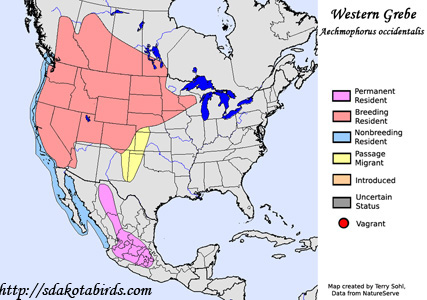 |
| South Dakota Status: Common migrant throughout the state. Common summer breeding resident in the northeast, uncommon elsewhere in the state in summer. |
Additional Western Grebe Photos
Click for a higher-resolution version of these photos
